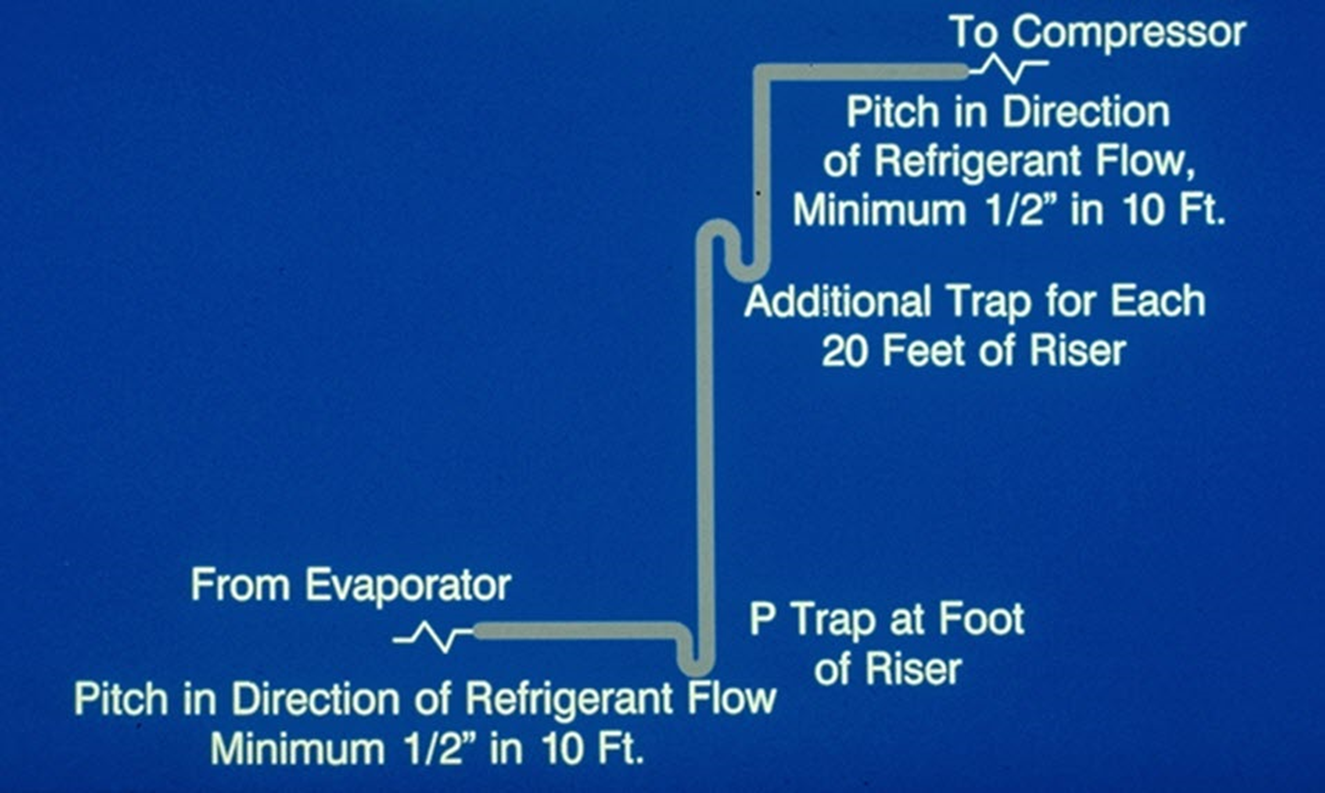Get Tech Tips
Subscribe to free tech tips.
Understanding “P” Traps in Refrigerant Lines
This article was written by Don Gillis with Chemours. Thanks, Don!
There are 3 main reasons we use “P” or “U” traps:
- Assisting in oil return to the compressor
- Preventing oil accumulation in the evaporator
- Preventing liquid refrigerant or oil from entering the compressor while operating or during the off cycle
Assisting in oil return is important to ensure that there’s adequate lubrication back to the compressor, especially during a part-load operation. Without good pipeline sizing, trapping, and good slope in your horizontal pipe runs (½” every 10 ft), chances are exceptionally good you are shortening the compressor’s life.
Refrigerant “P” traps also help prevent excessive oil from being trapped in the fan coil or evaporator. An excessive amount of oil in the evaporator will reduce the evaporator capacity, so you’ll always want to install a “P” trap in the suction line when the compressor is above the evaporator or when the distance to the condenser goes beyond the manufacturer’s specifications.
So, how does the oil trap work?
The primary function of the oil traps is used to help promote good oil return. At the riser, the refrigerant is flowing upward; if there is oil mixed in with the refrigerant, it will tend to fall back to the bottom of the riser because it is fighting gravity all the way. This is why there should be a “U” or “P” trap at the bottom of the riser.
Because the refrigerant-oil mixture will gradually lose velocity as it climbs, a basic guideline is to install an oil trap every 10–15 feet, depending on the system designer. (Always follow manufacturer’s guidelines.) Installing an oil trap every 10–15 feet of the riser will help temporarily store the oil as it makes its way to the top of the riser.

How do we size oil traps?
If you decide you want to make your own “P” trap, never go beyond 4x the size of the refrigerant line. This measurement is taken from the outside to the outside of the trap itself (see illustration below).

High suction line rises will inevitably lead to compressor lubrication problems if provision for oil return is not made. You must install an oil trap whenever the compressor is above the evaporator. During the low suction pressure operation towards the end of a cooling cycle, the oil will tend to separate from the suction vapor and cling to the surface of the piping, and it will then drain back, becoming entrained in the evaporator. During the off cycles, the oil trap will collect the oil so that when the compressor restarts, the higher suction pressure will return most of it to the compressor.
The suction “P” trap serves an important function both when the compressor is on and when it is off. When the compressor is running, the “P” trap is a turbulator that brings oil droplets up the elevated discharge line. During the off period for the compressor, the traps can catch and retain any oil left over on the walls of the piping that could otherwise potentially drain back into the compressor head.
Installing discharge line oil traps
Discharge line oil traps are installed in high discharge risers to prevent oil from draining back to the compressor head during off cycles. If oil is present in the head, a dynamic pressure will develop as the compressor restarts, resulting in damage to the compressor. Examples include valves, blown gaskets, the scroll set, broken connecting rods, and the crankshaft.
A discharge line trap plays an important function during both the on and off cycles of the compressor. During the cycles, the trap collects oil to be entrained in the discharge gas and carried by the refrigerant flow's velocity. Traps are utilized in the discharge riser and at the base of the riser. It is customary to reduce the riser by one pipe size to maintain proper velocities; you can also use a dual riser method for changing capacities.

The responsibility of an oil trap starts when the compressor turns off. The oil will attempt to return to the evaporator when the condenser is higher than the evaporator. As a result, the oil trap holds the oil and avoids the oil returning to the evaporator. You must use inverted traps whenever a suction header is above the evaporator.
Just remember this: good oil return is one the most important things in keeping a system well maintained. Please reach out to me at don.gillis@chemours.com If you have any questions about this topic or if you would like to schedule future training. Thanks again, everyone.
—Don Gillis, Senior Technical Trainer with Chemours











Comments
What happens if you go beyond the 4x size of line?
What happens if you go beyond the 4x size of line?
To leave a comment, you need to log in.
Log In